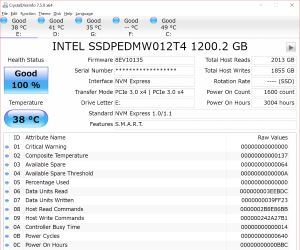

Sequential large block-size data should also result in write amplification near 1x because the data is sequential and thus doesn't fragment the drive. If I know the average write speed and the duration, I can figure out how much I wrote to the drive.

Fortunately, there is a a workaround: I wrote incompressible 128KB sequential data (QD=1) to the drive and took down the duration of each run and the Wear Leveling Count (similar to Media Wear Indicator). Samsung does not report NAND writes like Intel does and without NAND writes we can't know for sure how much data is written to the NAND because of write amplification. The reality can also be different from what manufacturers claim as we discovered in the Intel SSD 335 (though there is a high probability that it's just a firmware bug), so actually testing the endruance is vital. 1,000 - 1,500 P/E cycles is what I've heard for TLC NAND. No manufacturer has openly wanted to discuss the endurance of TLC, so the numbers we have seen before have been educated guesses.

Hence the endurance of TLC NAND is lower it simply cannot be programmed and erased as many times as MLC NAND and thus you can't write as much to a TLC NAND based SSD. TLC can't tolerate as much change in the voltage states as MLC can because there is less voltage headroom and you can't end up in a situation where two voltage states become one (the cell wouldn't give valid values because it doesn't know if it's programmed as "110" or "111" for example). programmed and erased), the room taken by one voltage state increases due to electron trapping and current leakage. The problem is that when the cell gets cycled (i.e. Voltages used to program the cell are usually between 15V and 18V, so there isn't exactly a lot room to play with when you need to fit twice as many voltage states within the same space. This results in eight voltage states instead of four (also means that one TLC cell has eight possible data values). The main difference is that MLC stores two bits per cell, whereas TLC stores three. We have explained the architectural differences between SLC, MLC and TLC NAND several times by now, but I'll do a brief recap here (I strongly recommend reading the detailed explanation if you want to truly understand how TLC NAND works):

We have tested MLC NAND endurance before but with the release of Samsung SSD 840, we had something new to test: TLC NAND. The move to ~20nm MLC NAND has reduced the available P/E cycles to 3,000, but that's still plenty. Back in the day when we had 3Xnm MLC NAND with 5,000 P/E cycles, people were worried about wearing our their SSDs, although there was absolutely nothing to worry about. Even though we have showed more than once that the endurance of today's MLC NAND based SSDs is more than enough for even enterprise workloads, the misconception of SSDs having a short lifespan still lives. NAND endurance is something that always raises questions among those considering a move to solid state storage.


 0 kommentar(er)
0 kommentar(er)
